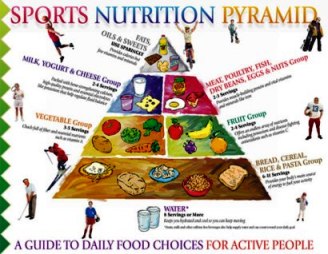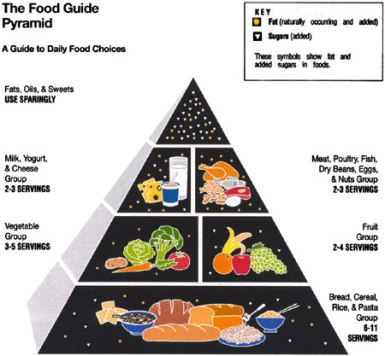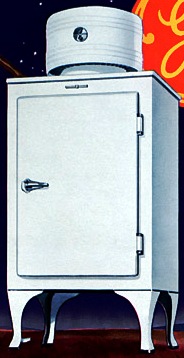Diet & nutrition:

The Food Guide Pyramid
The Food Guide Pyramid developed by the U.S. Departments of Agriculture and
Health and Human Services illustrates how to follow dietary guidelines and make
wise food choices. Select most foods from the bottom two levels of the pyramid (whole
grains/cereals, fruits and vegetables) and fewer foods from the top (fats, oils
and sweets), based on the recommended number of servings. Eat a variety of foods
from the five major food groups to help provide all the nutrients your body
needs each day.

Following the Food Guide Pyramid will help you eat a balanced diet
with moderate amounts of sugar, sodium and saturated fat. It also
will help you get the right amount of calories to maintain a healthy
weight.
Eating a balanced diet means eating a wide
variety of foods. A traditional way of getting a balanced diet has
been to eat a certain number of portions from certain food groups,
as defined by the US Department of Agriculture.
The five basic groups are vegetables; fruit; bread and cereal; dairy;
and meat, poultry, fish, and legumes (dry beans, lentils and peas).
It's recommended that you have four servings from the fruit and
vegetable group, and should include one good source of vitamin C
each day, such as citrus fruit, and a good source of vitamin A,
usually deep-yellow or dark-green vegetables. From the bread and
cereals group, it is recommended that you get six basic servings
including some whole-grain bread or cereals. The recommended
servings from the milk and cheese group vary with age, the highest
recommendations for teens and nursing mothers (four servings). Two
basic servings from the meat, poultry, fish and bean group are
recommended.
Then there's the sixth group: fats, sweets, and alcohol. It's a
group you want to avoid getting too many servings from. Foods in
this group have plenty of calories and not a fair balance of other
nutrients.
Eggs, as a protein source, are included in the same group as meat,
poultry, fish and beans. One egg is considered a serving in that
group. So if you eat two eggs for breakfast you have obtained your
recommendations from the protein group and should have no more egg,
meat, poultry or fish that day.
Daily Food Choices
|
FOOD GROUP |
SUGGESTED DAILY SERVINGS |
ONE SERVING |
|
Breads, Cereals, and Grain
Products |
6 - 11 |
1 slice of bread
½ hamburger bun or english muffin
a small roll, biscuit, or muffin
2 large crackers
½ cup cooked cereal, rice, or pasta
1 ounce of ready-to-eat breakfast cereal |
|
Fruits |
2 - 4 |
a whole fruit such as an
apple, banana, or orange
a grapefruit half
a melon wedge
a small cup of juice
½ cup of berries
½ cup cooked or canned fruit
½ cup dried fruit |
|
Vegetables |
3 - 5 |
½ cup of cooked vegetables
½ cup of chopped raw vegetables
1 cup of leafy raw vegetables (lettuce or spinach) |
|
Meat, Poultry, Fish, and
Alternatives |
2 - 3 |
amounts should total no more
than 7 ounces of cooked lean meat, poultry, or fish a
day
1 egg
½ cup cooked beans |
|
Milk, Cheese, and Yogurt |
2 |
1 cup of milk
8 ounces of yogurt
1½ ounces of natural cheese
2 ounces of process cheese |
Change the Way You Eat
Risk Factors
Set Some Weight-Loss
Goals
Making Sense of All
the "Diets"
What is a Calorie,
Anyway?
Keeping a Food Diary
- If You Eat It, Write It Down
Portion Control -
The Best New Buzzword
Get the Scoop on
Serving Sizes
Risk Factors
Being overweight - or even worse, obese - is a major risk factor in
developing many serious diseases and health problems, from arthritis to
heart disease to diabetes.
What does it mean to have a "risk factor"? Simply, this means that you
are putting yourself at greater risk for developing these serious
diseases by being overweight - much greater risk than you would have for
developing the problems if you were not overweight. This doesn't mean
that you will never get a disease if you lose weight, but your chances
of getting it are much, much lower.
When it comes to losing weight, you will have to set some goals for how
much weight you wish to lose. We recommend that you consult with your
physician before setting any goals or beginning any weight-loss or
exercise program. By talking to your physician, you can review any
particular health problems you have, your current weight, and any
problems you may have with increasing your physical activity.
Set Some Weight-Loss
Goals
If you think that you
have some weight to lose, and if your doctor agrees, then together you
should set some basic goals. Your weight-loss goals need to fit your
personal situation. Every person is unique and has individual challenges
associated with weight. Every person has a different body shape or style,
lifestyle and medical history.
That is why we suggest that you set weight-loss goals only with the help
of your doctor. Make an appointment to see your doctor, or bring up this
issue at your next visit. There are some personalized tests that you can
do with your doctor that will show you if you are overweight, and by how
much.
With your doctor's help, you will set some basic goals for your
weight-loss efforts. These goals might include:
How much weight you should lose
A range, in pounds, to aim for and to stay within once you achieve that
level
How long you should try this program, tracking your weight-loss efforts
to determine your progress.
When it comes to how long you should try any weight-loss effort, it
really depends on you. The changes we suggest are long-term changes.
Permanent changes, in fact. We're suggesting that you set goals for
yourself to make changes to your diet and eating habits that will last a
lifetime. What you should aim to create is a nutritious, healthy,
balanced diet. By eating this way, and by incorporating sensible
physical activity into your lifestyle also, your weight will likely
reduce as a result.
Losing weight by making gradual, healthy changes will be much easier
than trying to make a drastic, short-term change to the way you eat. And
this type of weight loss should be easier to maintain because you will
become accustomed to eating in a new way. It will seem natural to eat
nutritiously.
Making Sense of All the "Diets"
You may have read about many "diets" or weight-loss
programs that claim you can lose weight by cutting
out one type of food or another from your diet. You
may have friends who have lost dramatic amounts of
weight on various popular plans. These programs are
often called "elimination diets," because they
suggest that you eliminate a whole food group from
your menu in order to eliminate excess fat from your
body.
For instance, some weight-loss programs tell you to
eliminate carbohydrates. Others tell you to cut
almost all fats out of your diet. Some programs push
eating high amounts of protein. Some of these
programs may work for you if your desire is to lose
weight. By why do they work?
The reason these diets work is because they cut
calories from your diet. These programs are known as
calories-deficient diets. There's that old word
again - calories - but nobody has been using it for
years, have they? Calorie has been replaced by other
terms, such as carbohydrates, fats and proteins,
right?
No - calories are still the key to any weight
program and any weight-loss strategy. Every food has
a caloric value. You can read the caloric value of
most foods by checking the nutrition label on the
side of packages, or by looking up the value in
calorie counter books available in most bookstores.
No matter how you package the plan, the key to
losing weight is calories, not fat or carbohydrates
or any other nutrient.
In other words, you may cut out a lot of the fat in
your diet by eating "fat-free" or "low-fat" foods in
abundance. These foods can include things like
celery or plain baked potatoes, but they can also
include jellybeans, licorice sticks, fat-free
chocolate pudding, fat-free turkey wieners and
fat-free cheese. You might think that you could eat
these foods in unlimited quantities, because these
foods technically have little or no dietary fat. But
all of these foods have calories, and some of these
foods are quite high in calories. By eating them in
large amounts, you could be eating too many calories
for your body's needs. And that leads to excess
weight.
What is a Calorie, Anyway?
What is a calorie? And why is this term important when we're talking
about weight? A calories is the amount or measurement of heat necessary
to raise the temperature of one gram of water one degree on the Celsius
scale.
Excuse me? What does this have to do with why my pants won't fit?
A calorie is also the unit of measurement of energy produced by food
when it is oxidized, or used, in the body. Calories are like fuel for
our bodies. We need them for our bodies to run. But if we pump more fuel
into our bodies than we need for the amount of activity we do, the
excess fuel just sits there. Your body will store this excess, unused
fuel. It may store it as muscle, if you perform enough physical,
muscle-building exercises such as weightlifting, or it may store it as
fat.
You need to maintain a balance between the amount of calories you take
in (food) and the amount of calories you use (exercise). You "burn" your
body's fuel - calories - when you perform physical activities, and you
also burn calories just by sitting still, breathing and living each day.
If you perform enough physical activity, you may increase the amount of
calories (or energy units) you burn each day and raise the amount of
calories (or energy units) you need each day. So a person who is
physically active can eat more calories each day without gaining weight,
because this person uses the fuel he or she pumps in, instead of storing
it as fat.
Each person is different when it comes to the amount of calories he or
she needs each day. The amount of calories a person needs for fuel
varies according to age, height, gender, amount of physical activity and
other factors.
If You Eat It, Write It Down
The best way to grasp how many calories per day you
eat now, and how many you may be accustomed to
eating, is to keep a food diary. Try this exercise
for a week. Simply write down the foods you eat,
including portion size. Try to estimate the caloric
content of each of these foods using a calorie
counter book or by looking at the nutrition label on
the packaging of the food. You may be surprised how
easily calories add up!
Here are a few examples of common foods, a typical
portion size and their approximate caloric values. (These
caloric values are measurements for a basic serving
size. Check the nutrition information on the labels
of our foods, or measure your servings, to determine
caloric value.)
As you can see, the caloric value of different foods
varies tremendously! And the amount of the food you
can eat as a normal "portion" also varies quite a
bit. It's important to rethink how you may look at
what foods are "healthy," "nutritious" or "diet."
For instance, a Caesar salad, which is often coated
with very highly caloric dressing, grated cheese and
buttery croutons, can take up a large portion of
your daily calorie budget. Does this mean you have
to give up Caesar salads? Maybe not. You could
budget the rest of your day's calories with
low-calorie foods so you have room to indulge in
your favorite salad. You could eat a much smaller
portion of the salad to cut the calories you are
eating. Or, you could make your own Caesar salad,
with lower calorie dressing, adding low-calorie
fresh vegetables for crunch rather than buttery
croutons.
Whatever you choose to eat, do your best to estimate
the caloric value of the foods you consume and note
them in your food diary. It wont be possible to know
the exact caloric value of everything you eat,
particularly when you eat in restaurants. But if you
can estimate the calories you are eating, that will
be a big help for you as you learn to budget
calories wisely.
You can keep your food diary in a spiral notebook, a
bound journal on your home or work computer, or any
way you choose. It's important you find a method
that is easy for you to use. Try not to keep a
mental record of what you ate and then write it down
later - it's easy to block out a few chips here or a
banana there.
Portion Control - The Best New Buzzword
Even when you eat foods that are low in fat or relatively low in
calories, the amount you eat is the most important factor. You will want
to keep the number of calories you eat per day within a healthy range,
but you still want to eat a variety of foods for taste and nutrition.
And you will want to eat enough to keep you satisfied.
You can eat almost any type of food and still stay within a healthy
range of calories for the day. You simply have to decide how you will
spend your budget of calories. Higher-calorie foods, such as french
fries, will use up more of your budget than baked potato chips. If you
want to budget your calories wisely, look at the sizes of the portions
you are eating. Portion control is the most important diet buzzword you
need to know. One of the biggest reasons so many Americans are
overweight is that they have no concept of healthy food portions.
While it is important to consider the type of foods you are eating, it's
really more important to look at the quantity of food you eat. Many
people know the right kinds of food to eat. They know that baked chicken
is more nutritious than fried chicken, for example. But many people have
no concept of how much food is too much - and that misconception is a
major contributing factor in their weight problem.
If the average adult female needs about 1,600 calories a day, does she
need to eat a 1,200 calorie plate of pasta and meatballs at one meal?
The answer is no - a portion size of pasta is one-half cup. But most of
us have become used to eating larger and larger portions, and we feel
deprived by going back to eating reasonable portions of food.
Many people underestimate how much they really eat at a typical meal.
Like many Americans, you have come to expect large portions at
restaurants, but instead of eating half the meal and taking the other
half home (or sharing it with your dining partner), you eat the whole,
gigantic portion. The result: You feel stuffed, sluggish and probably
consume too many calories than you need in a day.
When it comes to eating, most people are driven by what they see, not by
how they feel. Your hunger is driven by instinct. By putting too much
food in front of you, you will perceive this oversized meal as normal.
If you change that habit, and start serving yourself smaller portions,
you will perceive this smaller amount as a normal meal.
There are a few easy ways to determine healthy portion sizes for the
various foods you eat.
On packaged foods, look at the "serving size" measurement on the
nutrition label of the food's package. If you look on a box of cookies,
and the serving size is two cookies, that means one portion is two
cookies - not six cookies.
When following a recipe, look for how many "servings" the recipe makes.
If the recipe says "serves four," that means that one portion is one
fourth of the total amount of the food you prepare by following the
ingredients and measurements in the recipe.
Get the
Scoop on Serving Sizes
Do you know what you're eating?
You may find it difficult to adjust your sense of a
normal portion of food to reality. You may say, "I
won't be satisfied with one cup of dry cereal." The
key is to eat more slowly, to eat one bite at a time.
Don't shovel your food into your mouth as if you
were in an eating contest. Your body needs a little
time to absorb your food so you don't feel so hungry.
It takes 20 to 30 minutes to feel a sense of
fullness when you are eating. This sense of being
satisfied or full tells you when to stop eating.
That's why it's important to eat slowly. If you try
to consume as much food as possible in 20 minutes,
by the time your body catches up and feels satisfied,
you are over-stuffed. You feel as if you couldn't
eat another bite. Does that sound familiar?
Slow down when you eat. Eat one bite at a time, chew
your food thoroughly and savor the taste of your
food. That may be a hard habit to adopt, but you can
make this one of your change-your-life goals.







